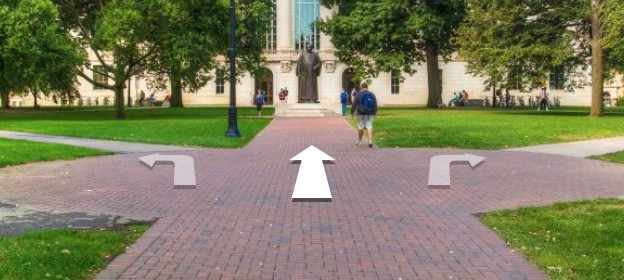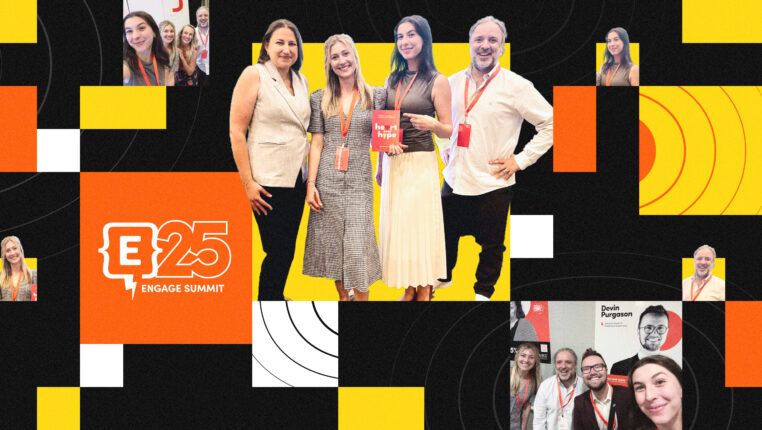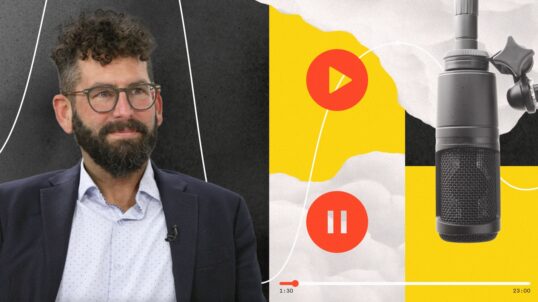If “seeing is believing,” visual content has the power to inform and persuade an audience more effectively than words alone. While written content is tremendously beneficial for any higher education marketing campaign, virtual college tours and other visual elements can add even more power to your university website.
What Are Virtual Tours?

Virtual college tours can take a variety of forms. At their most basic, however, they provide a visual representation of a campus or a location on campus. For instance, you might have seen 360-degree virtual tours, which allow the viewer to experience a panoramic image of the location. These types of tours give the viewer interactive control. He or she can shift left, right, up, and down to view every detail of the image.
Interactive maps also allow colleges to create virtual campus tours. An illustrated map offers links to specific locations on campus. Users can click on each location to view photographs, videos, statistics, and other relevant information, as well as links to other pages on the university’s website.
Then you have video campus tours, which take viewers on a linear tour of the facility. These tours often feature narration, music, and other audio effects to immerse the viewer in the campus world.
There are also simulated virtual tours, which are used to provide an illustrated mock-up of a location that has not yet been built. If your institution is planning a new wing or a building for a particular school on your campus, for instance, you might use a simulated virtual tour to inspire donor interest.
Virtual Tours Benefits
More than 6 million people take a virtual tour on any given day, which means Internet users crave the immersive experience a tour provides. Additionally, virtual tours provide other benefits, such as:
- Increased user engagement: Prospective students and donors feel more connected to your univeristy and will interact with your website longer.
- Improved attention: Viewers will pay better attention to the content because of virtual tours’ interactive elements.
- Knowledge retention: Prospects will remember the information they gleaned from your tour for longer periods of time because of the visual associations.
- Interaction: The very nature of interactivity makes it more compelling and instructive than passive activities.
- Lack of distraction: Users will be less likely to click away when something else catches their eye.
- Immediate engagement: Don’t give prospects a chance to find a reason to click away. Instead, grab their attention from the beginning.
- Hands-on approach: Increase information absorption and retention through a virtual tour’s hands-on components.
- Understanding: When you deliver complex or difficult information, users will comprehend it more readily through the visual and interactive experience.
- Learning style: Many people learn more easily when there’s a visual component. Additionally, virtual tours often incorporate audio, as well.
- Conversion: Research demonstrates that virtual tours lead to higher conversion rates for higher education institutions.
Additionally, in-person college visits often require time, money, and travel. When a prospective student lives in another state, he or she needs a compelling reason to book a plane or bus ticket, and even for local residents, many students will forego campus visits because they’re busy studying, researching colleges, and engaging in social activities. Virtual college tours allow prospective students to “experience” the college campus without any time or financial commitments.
Virtual tours are far from universal on university websites. While many colleges have created and used tours to great effect, the vast majority have not. Consequently, you can gain a competitive advantage by adding this functionality to your website.
Virtual tours are also a great way to highlight an upcoming campus building. Whether your institution is constructing a new science lab or a library, potential donors want to know how their dollars are benefiting your school. By providing a virtual tour, you put their fears to rest, demonstrate commitment to the project, and allow donors to experience the new development viscerally.
How to Engage Prospective Students with Virtual Campus Tours
Virtual tours are an effective way to increase viewer retention and engagement. Here are few examples of how some of the leading Universities are utilizing virtual tours to engage prospective students.
The George Washington University offers a fully interactive map, which creates a virtual tour without any advanced video or photography skills needed. While it isn’t a full campus tour, it’s an immersive and interactive experience that encourages the viewer to continue to click on various campus buildings and locations.
Meanwhile, Yale University takes a different approach. It offers several virtual tours, each of which focuses on a specific point of interest: the campus, athletics, engineering, and so on. Each tour features a “tour guide” who offers commentary on the locations you visit during the tour. Furthermore, there’s a map in the upper right-hand corner that orients the viewer to each location and provides additional interactivity.
Emory College, on the other hand, uses the traditional 360-degree version of virtual college tours. From the quad and the library to the bookstore and the health sciences center, you get a real sense of what each location looks like and how to move within it. Plus, an information box provides background on each location and explains its purpose in the context of the campus. You can also open an interactive map that shows where the location is found, and click markers on the map to transport yourself to the next location that interests you.
Some colleges have created virtual tours around a specific theme. At Texas Christian University, for example, the virtual tour focuses on the concept of “Find[ing] Connections at Every Turn.” In other words, each segment of the virtual tour shows how students and faculty connect with one another to socialize, study, learn, and develop. Themes can help cement an emotional connection with the viewer and establish your campus culture more effectively. The TCU campus tour is also unique in that it progresses from a first-person perspective in video. It’s like a Go Pro tour of a college dorm, lecture hall, cafeteria, and library.
How Virtual Tours can Inspire Donors to Contribute
Virtual tours are also a great way to engage and influence potential donors. Nonprofit expert Carolyn M. Appleton calls these “wonderful tours” and explains that they can vastly improve any fundraising campaign thanks to their immersive content. Though Appleton talks specifically about virtual tours for buildings or other structures you hope to build with donated funds, they can prove useful for a variety of purposes.
For instance, you might use a virtual tour to remind alumni about their treasured college experiences. When people feel more emotionally connected to a cause, they’re more likely to donate to it. Showcase beloved spots on campus and treasured university traditions to encourage sentimentality. This is a great way to take your alumni back to their “glory days” and inspire gratitude for all your school did to launch their lives and their careers.
You could also create virtual tours to show your alumni what has changed on campus. Northern Arizona University has done just that, using a virtual tour to take alumni through buildings and outdoor spaces that have been remodeled or updated since they graduated. It’s a great way to showcase the myriad ways in which universities benefit from donated funds, whether it’s updating equipment in the science lab, buying more books for the library, or renovating a building that no longer serves the needs of the student body.
San Diego State University uses a similar approach for its Parma Payne Alumni Center. The center has built a virtual tour that takes SDSU alumni on a Google Maps-inspired tour of the campus, providing brief anecdotes and facts about each location. Since most people have used Google Maps at least a few times, they’re familiar with the functionality, which makes the experience recognizable but nonetheless novel.
You could also create virtual tours for individual colleges at your university. The University of Maryland, for instance, has used a virtual tour to helm its page for Medical College alumni. Beneath the tour, you can read a history of the college and learn about its impact on medical science and future doctors. This strategy shows alumni and potential donors the ways in which the college fits with the rest of the world and with the industry it perpetuates.
However, alumni aren’t the only donors you want to attract.
One way to inspire potential donors is to showcase your need for funds by explaining how you provide technology, tools, and equipment for your students. Many people don’t realize the sheer volume of money required to keep a university running, so you can use virtual tours to educate and inform as well as inspire. When potential donors know how you’ll use their funds, they can donate in good conscience.
Virtual tours are also an excellent tool for improving donor relations and stewardship. You’ll keep donors updated on the latest advancements at your school as well as the progress you’ve made on developments. For instance, if you’ve collected money to break ground on a new building, you can use virtual tours to keep donors apprised of each stage of the process.
Virtual Tours Best Practices
Identify Goals: You shouldn’t create virtual campus tours just to have one on your university website. Your tour needs a specific purpose and goal, which means you must understand what your audience wants. Are your prospects interested in your school’s history? If not, you probably don’t need to include that information in your virtual tour. Conversely, a school that has a rich history in which students continually express interest might need to make history a focal point of the virtual tour.
Less Text, More Images: Virtual tours should move quickly and provide brief talking points for each segment. Don’t drown your audience in data points; instead, give them the highlights to engage their interest further. Imagery should dominate over text so viewers feel free to lose themselves in the experience.
Include People: Show students socializing with one another, studying for exams, playing sports, walking to class, and soliciting guidance from professors. The goal of a virtual tour is to provide an accurate snapshot of campus life. You want your prospective students to imagine themselves on campus, grabbing a cup of coffee between classes at the quad or studying in the library.
Virtual Tours Offer Tremendous Value
Whether you’re attracting prospective students, engaging alumni, or inspiring potential donors, virtual tours can provide tremendous value.



